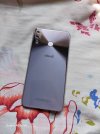Huawei Technologies Co has finally run out of in-house-designed
semiconductors for its
smartphones after US trade sanctions effectively cut the company’s access to advanced new chips, according to a report by Counterpoint Research.
Shenzhen-based Huawei, which briefly
surpassed Samsung Electronics to lead global smartphone shipments in early 2020, has struggled to get new in-house-designed integrated circuits (ICs) manufactured by a major chip foundry after
Washington tightened trade restrictions in August 2020, covering the firm’s access to semiconductors developed or produced using US technology, from anywhere.
Privately-held Huawei and chip design arm
HiSilicon were
added to the US government’s trade blacklist, known as the Entity List, in 2019. At the time, HiSilicon said it had
a backup plan to ensure the group’s survival, while research firms Haitong and Canalys indicated that Huawei had been stockpiling critical US components for almost a year.
“Based on our checks and sell-through data, Huawei has finished its inventory of HiSilicon chipsets,” Counterpoint said in its latest report on global smartphone application processor market share.
HiSilicon’s share of the global smartphone application market this year reached zero in the third quarter, down from 0.4 per cent in the previous quarter and 3 per cent in the second quarter of last year.
The report added that it was “not possible” for Huawei to obtain advanced new ICs from major contract chip makers, such as
Taiwan Semiconductor Manufacturing Co or
Samsung, because of the tightened US restrictions.
Huawei did not immediately reply to a request for comment on Wednesday.
As of the third quarter, the global market for smartphone system-on-a-chip shipments was led by MediaTek,
Qualcomm and
Apple, according to the Counterpoint report.
The latest industry data highlights the difficulties that Huawei, which operates in more than 170 countries, continues to go through three years after it was blacklisted by the US.
Before the tightened US sanctions, HiSilicon accounted for 16 per cent of the global chipset market share in the second quarter of 2020, according to Counterpoint data, on the back of its shipments of advanced Kirin chips used on Huawei’s smartphones.
HiSilicon also
dropped out of the rankings of the world’s top 25 semiconductor vendors because of the stifling US trade restrictions, which also reduced China’s overall share in the global chip market, according to a report published in April by research firm Gartner.
Its Kirin chip supply constraints have kept the smartphone business of Huawei, the
world’s largest telecommunications equipment maker, under pressure. In September, the company
launched its new flagship Mate 50-series smartphones without
5G mobile connection owing to the US sanctions.
HiSilicon also
dropped out of the rankings of the world’s top 25 semiconductor vendors because of the stifling US trade restrictions, which also reduced China’s overall share in the global chip market, according to a report published in April by research firm Gartner.
Its Kirin chip supply constraints have kept the smartphone business of Huawei, the
world’s largest telecommunications equipment maker, under pressure. In September, the company
launched its new flagship Mate 50-series smartphones without
5G mobile connection owing to the US sanctions.
The company’s latest flagship smartphones, which have 4G and satellite connections, are powered by Qualcomm chipsets.
Once China’s biggest smartphone vendor, Huawei has seen its market share fall in its home market. In the third quarter, the company remained out of the top-five vendor rankings in China, which was led by
Vivo,
Oppo, former Huawei budget handset brand
Honor, Apple and
Xiaomi, according to data from tech market research firm Canalys.
Huawei has recently been working to expand its patent-licensing arrangements, as part of efforts to boost revenue amid the struggles of its once-lucrative smartphone business. Earlier this month, Huawei
agreed to license some of its smartphone technologies to rival Oppo.
The Chinese tech giant’s inventory of smartphone chips designed by semiconductor unit HiSilicon reached zero in the third quarter.

amp.scmp.com








 ) spotted Huawei building a new fab.
) spotted Huawei building a new fab. 



